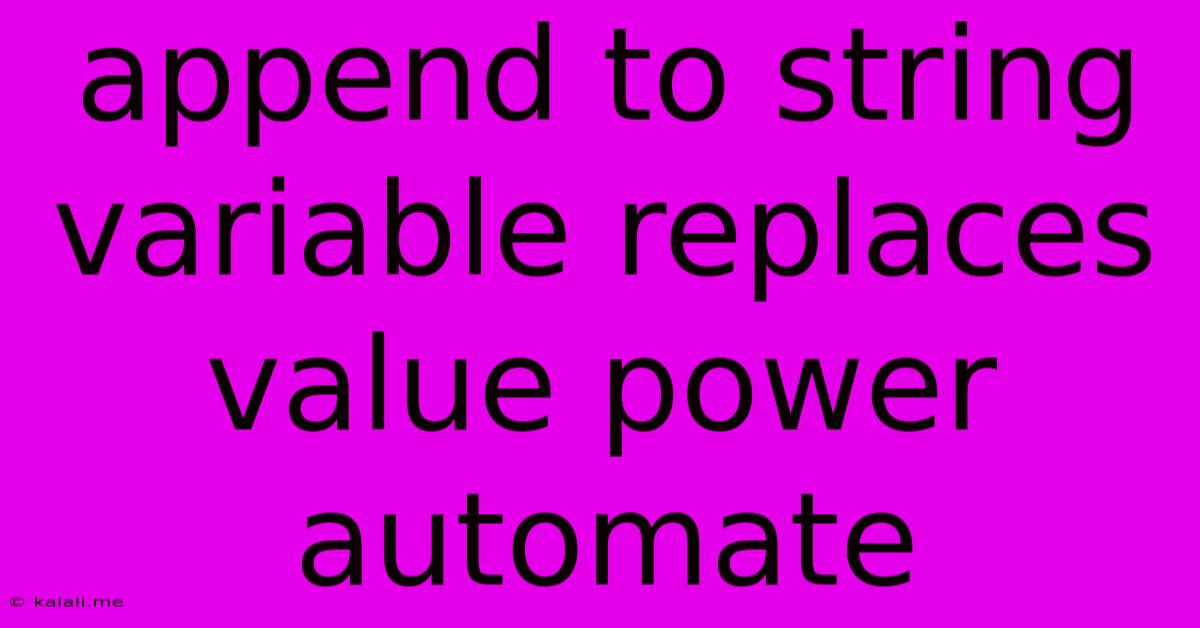Append To String Variable Replaces Value Power Automate
Kalali
Jun 04, 2025 · 3 min read

Table of Contents
Appending to String Variables vs. Replacing Values in Power Automate: A Comprehensive Guide
Power Automate offers several ways to manipulate string variables, crucial for building robust workflows. Understanding the difference between appending to a string and replacing its value is key to crafting efficient and accurate automations. This article explores both methods, highlighting their use cases and providing clear examples. Choosing the correct approach depends entirely on your desired outcome within your Power Automate flow.
This article will cover:
- Understanding String Manipulation in Power Automate
- Appending to a String Variable
- Replacing the Value of a String Variable
- Choosing the Right Method: Appending vs. Replacing
- Advanced String Manipulation Techniques
Understanding String Manipulation in Power Automate
String manipulation is a fundamental aspect of many Power Automate workflows. Whether you're constructing email bodies, processing text from documents, or building dynamic file names, the ability to work with strings is essential. Power Automate provides several built-in actions and expressions to achieve this, making it incredibly versatile for a wide range of automation tasks.
Appending to a String Variable
Appending adds text to the end of an existing string variable. This is ideal when you want to build a string incrementally, adding new information without erasing the previous content.
How to Append:
Power Automate utilizes the concat() expression to append strings. This function takes multiple inputs and combines them into a single string. Here’s how you would append to a string variable named myString:
concat(variables('myString'), ' New Text')
This expression takes the current value of myString and adds " New Text" to the end. The result is then assigned back to the myString variable using a "Set variable" action.
Example:
Let's say myString initially holds "Hello". After appending using the above expression, myString will become "Hello New Text". You can chain multiple append actions to build more complex strings.
Use Cases:
- Building dynamic email subject lines or body content.
- Concatenating data from multiple sources into a single string.
- Creating log files by adding entries sequentially.
Replacing the Value of a String Variable
Replacing a string's value overwrites the entire existing content with a new value. This is useful when you need to completely change the string's contents, rather than just adding to them.
How to Replace:
This is straightforward. Simply use a "Set variable" action and provide the new string value you want to assign to your variable.
Example:
If myString contains "Hello", the following "Set variable" action will replace its value with "Goodbye":
- Variable name:
myString - Value:
Goodbye
After this action, myString will contain only "Goodbye"; the original "Hello" is completely gone.
Use Cases:
- Resetting a string variable to a default value.
- Updating a string variable with new data received from an external source.
- Replacing parts of a string using string manipulation functions (discussed below).
Choosing the Right Method: Appending vs. Replacing
The choice between appending and replacing depends entirely on your workflow's logic.
- Append: Use when you need to cumulatively build a string, adding new information to the end without losing the original content.
- Replace: Use when you need to completely overwrite the existing string with a new value.
Advanced String Manipulation Techniques
Power Automate offers several expressions beyond concat() for more sophisticated string manipulations:
substring(): Extracts a portion of a string.replace(): Replaces specific occurrences of a substring within a string.length(): Returns the length of a string.trim(): Removes leading and trailing whitespace.split(): Splits a string into an array of substrings based on a delimiter.
By mastering these techniques, you can create powerful and flexible Power Automate flows that effectively handle various string manipulation requirements. Remember to carefully consider whether appending or replacing best suits your specific automation needs. Choosing the right method significantly impacts the efficiency and accuracy of your flows.
Latest Posts
Latest Posts
-
Symptoms Of Bad Hot Water Heater Element
Jun 06, 2025
-
Baking Soda Is Base Or Acid
Jun 06, 2025
-
Albert Einstein Blind Belief In Authority
Jun 06, 2025
-
Jezebel In The Book Of Revelation
Jun 06, 2025
-
Navigate To Another Component On Initialization Using Urladdressable
Jun 06, 2025
Related Post
Thank you for visiting our website which covers about Append To String Variable Replaces Value Power Automate . We hope the information provided has been useful to you. Feel free to contact us if you have any questions or need further assistance. See you next time and don't miss to bookmark.